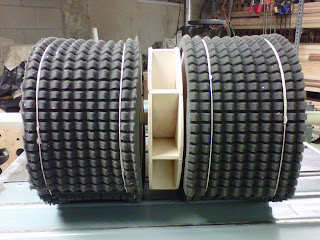Now my wheel will go into test mode: I will fill the tank with fresh water and see if the wheel can provide enough biological filtration to effectively start up or cycle the tank.**
Friction was literally the biggest obstacle to getting the wheel moving. Specifically the wheel had to be able to overcome the resistance the tank water would put against the paddles. To combat this, I angled the paddles so they retain more water as they spin down and then release water as they start to spin upwards. Additionally, I just barely
submersed the drums and water wheel. This minimized the surface area of paddle that must travel through the tank water, but it still ensured that the entire drum surface contacted the water as it rotated. In future versions, I would build a water wheel with a smaller diameter than the drums so that the paddles would not have to pass through water at all.
Initially, I tried corrugated foam as the medium for biological filtration. While it looked pretty badass - think remote control car wheels on steroids - its weight was too great for the wheel to turn once it absorbed water.
So I swapped the foam out for fiberglass screen. The screen won't absorb water and I chose fiberglass because I was concerned about metal screen leaching contaminants into the water.
The final prototype - let's call it wheel.0 - is seen below. Less studly, sure, but more effective. I have to give a big thanks to my friend Doug for all the help with the construction of the wheel. He took my initial designs, helped me bring them to life, and put a beautiful finish on them. I'll post soon a step by step method for building the wheel if you'd like to emulate it. There you'll be able to see the evolution of this wheel from its humble beginnings. Stay tuned for that and analysis of the wheel's performance!
**Cycling the tank: When new water is put into the tank there are very few nitrifying bacteria. As a result, fish waste, ammonia, begins to build up in the water because there is too much of it for the few bacteria to eat. Meanwhile the bacteria begin multiplying, feeding off the increasing levels of ammonia. Eventually, usually after a few weeks, the bacteria population grows large enough so that they consume more ammonia than the fish produce. This causes the ammonia level to drop, and it eventually drops back to zero.
Properly cylcing a tank is important because ammonia is toxic to fish at high levels.



No comments:
Post a Comment